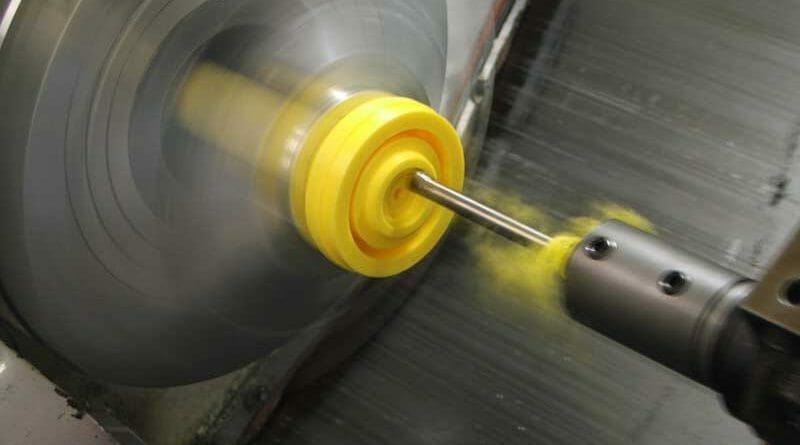Indiana Spends $1 Billion on Workforce Development Annually
Just after 4 p.m. on a recent afternoon, Neal Allman was cleaning up the work area around the Haas vertical machining center he’d been working at for the day. The mills, primarily used to machine-cut metal pieces, are a key piece of the advanced manufacturing industry and not enough Hoosiers know how to work them. He was also keeping an eye out for Gov. Eric Holcomb, who had just finished touring Vincennes University’s Haas Technical Education Center, where Allman is in the sixth week of a 15-week course called Right Skills Now CNC Machining.
Holcomb was kicking off a tour of similar facilities around the state, looking for examples of what the governor would like to see Indiana embrace as the state prepares to overhaul its workforce development initiatives next year. “You don’t have to recreate something that’s working, but you can expand on it,” Holcomb said. “We’re looking at 2018-19 as a pivotal time for the state of Indiana.”
By the time Allman and his six classmates finish their course, they will have earned up to nine different industry credentials and will be ready to go to work operating a computer-controlled machine in an automotive, health care or other manufacturing facility.
Salaries for an entry-level machinist often start around $20 an hour, paying an annual salary of more than $40,000.
Allman was hoping for a chance to thank the governor. A Workforce Ready Grant, part of Holcomb’s Next Level Jobs initiative, was paying for the bulk of Allman’s training.
At more than $10,000, the machining course and similar programs for industrial maintenance and quality control technicians aren’t cheap, especially for the unemployed or underemployed people for whom they’re designed.
With a little extra help from Vincennes, Allman had the entire cost covered.
“I take it very personal that Governor Holcomb and the State of Indiana would invest in me like this,” Allman said. “They’re giving me an opportunity to better myself and the trajectory of my family.”
Indiana has a shortage of workers like Allman. Holcomb said the state has 85,000 unfilled jobs because employers can’t find skilled workers.
Indiana also has more than 700,000 adults who started college but didn’t finish, and another 475,000 without a high school diploma.
If the state can leverage its resources — the state spends $1 billion annually on workforce development programs — to get those people the skills employers are looking for, the state could fill its worker shortage, and then some.
And there lies the heart of Holcomb’s vision for Indiana’s workforce development efforts, an otherwise nebulous concept that can be hard to define and even harder to picture.
Here’s what it looks like at the Haas training center, which touches on three main pillars of Holcomb’s vision for workforce development in Indiana:
The center is preparing to start a new early college program, in conjunction with Lebanon High School, where students will spend half days at the school and half days at the training center, earning industry credentials.
There is growing interest in turning workforce development efforts toward high school, middle school and even elementary school students as a means to (eventually) fill the state’s worker shortage. The thought goes that by getting kids exposed to these industries and thinking about these jobs earlier, the state can build a pipeline of kids who graduate from high school ready to work.
During a roundtable discussion with state, education and industry representatives last week, Holcomb told a story about young kids he saw visiting automotive factories in Japan.
“It’s part of their education,” he said.
The state is already making moves toward that model, with new high school graduation requirements that encourage work-based learning and proposed legislation to create career coaching programs.
Another major piece of Holcomb’s vision for workforce development is reaching more of Indiana’s under-educated adults and getting them into short, credential-oriented training programs like those offered at the Lebanon facility.
There are unfilled jobs waiting,” Holcomb said. “Our employers are craving that skilled workforce.”
Some of those students will be like Allman, who came to the program looking to make a change after spending decades as a graphic artist in the light manufacturing sector but watching his wages stagnate over the last few years.
Others, though, will be like Travis Heflin, in his fifth week of the industrial maintenance program and there on the dime of his employer, Subaru.
That’s the third piece: leveraging more of the $1 billion Indiana spend on workforce programs right now to help employers “skill up” their existing workers into better jobs. The Haas training center has partnership with Subaru, Caterpillar and others to provide training to current employees.
Heflin said he had to take several tests and go through an interview process to be selected for the program and there’s a line of guys behind him, waiting to get in.
“A large line,” Heflin said.
Not only does Subaru pay for the course, the company pays their employees’ salaries during the 15 weeks they’re in class full time. Once the workers graduate from the course, they’re able to move into more-skilled, better-paying jobs.
Brad Rhorer, assistant senior manager dealing with human resources for Subaru of Indiana, said the company pays for about 75 percent of the cost and the rest is covered by state and federal workforce grants.

